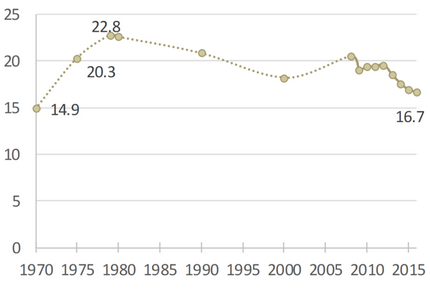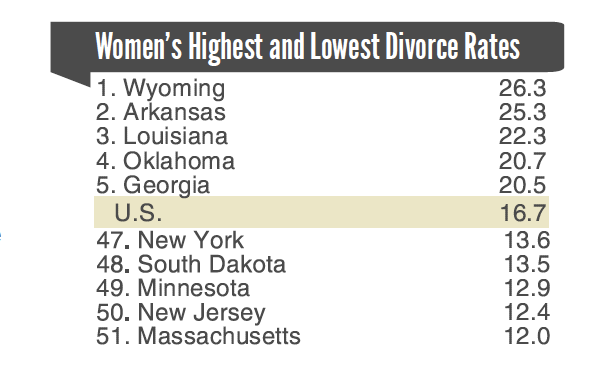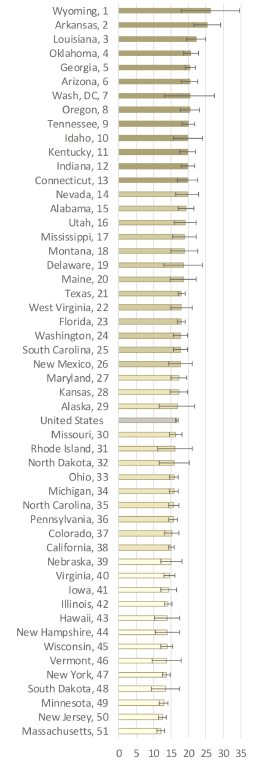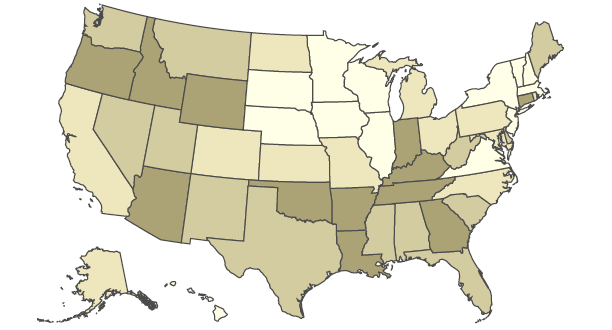Divorce Rate in the U.S.: Geographic Variation, 2016
This Family Profile has been updated with new data. Click here to access the most recent version, FP-20-25.
(Updated profiles include: FP-09-02, FP-13-14, FP-14-17, FP-15-18, FP-16-21, FP-17-24, FP-18-21, FP-19-23)

Family Profile No. 24, 2017
Author: Paul Hemez
The Divorce Rate, 2016
- The divorce rate (represented as the number of divorces per 1,000 married women aged 15 and older) continued to decline in 2016, reaching a 40-year low.
- The divorce rate was 16.7 divorces per 1,000 married women in 2016, down from 20.5 in 2008 when the rate was at its highest in recent years.
- Just over one million women (1,098,805) divorced in 2016, a drop of over 210,000 since 2008 when 1.3 million women divorced.
*The divorce rate decreased by 26% from the apex in 1980 (22.6) to 2016.
Figure 1. Women's Divorce Rate, 1970 - 2016

Five Highest and Lowest Divorce Rates, 2016
- Wyoming had the highest divorce rate in 2016, with over 26 marriages per 1,000 ending in divorce.
- Massachusetts had the lowest divorce rate, with about 12 marriages per 1,000 ending in divorce.
- Massachusetts’s divorce rate was less than half the rate of Wyoming's.
Table 1. Women's Highest and Lowest Divorce Rates

State Rankings and Geographic Variation in Divorce Rates, 2016
Figure 2. State Variation in the Adjusted Divorce Rate per 1,000 Married Women Aged 15+

- The thirteen states with the highest divorce rates (making up the 1st quartile) had rates of at least 19.75 divorces per 1,000 married women in 2016.
- The thirteen states that experienced the lowest divorce rates (making up the 4th quartile) in 2016 had fewer than 15.05 divorces per 1,000 married women.
Figure 3. Geographic Variation of Women's Divorce Rate Among States, 2016

- States with the highest divorce rates (in the 1st or 2nd quartiles) were predominately found in the Southern and Western regions of the country.
- Exceptions include Colorado, California, Maryland, North Carolina, and
Virginia, which experienced divorce rates in the 3rd or 4th quartiles.
- Exceptions include Colorado, California, Maryland, North Carolina, and
- States with the lowest divorce rates (in the 3rd or 4th quartiles) were
located in the Midwest and Northeast regions of the United States.- Exceptions include Indiana, Connecticut, Delaware, and Maine, which
were in the first two quartiles of divorce rates.
- Exceptions include Indiana, Connecticut, Delaware, and Maine, which
References
- Clarke, S. C. (1995). Advance report of final divorce statistics, 1989 and 1990. Monthly Vital Statistics Report, 43(9). National Center for Health Statistics. Retrieved from https://www.cdc.gov/nchs/data/mvsr/supp/mv43_09s.pdf
- National Center for Health Statistics (1974). Summary report final divorce statistics, 1970. Monthly Vital Statistics Report, 23(2). U.S. Department of Health, Education, and Welfare. Retrieved from https://www.cdc.gov/nchs/data/mvsr/supp/mv23_02s2acc.pdf
- National Center for Health Statistics (1977). Advance report of final divorce statistics, 1975. Monthly Vital Statistics Report, 26(2). U.S. Department of Health, Education, and Welfare. Retrieved from https://www.cdc.gov/nchs/data/mvsr/supp/mv26_02s2acc.pdf
- National Center for Health Statistics (1983). Advance report of final divorce statistics, 1980. Monthly Vital Statistics Report, 32(3). U.S. Department of Health and Human Services. Retrieved from https://www.cdc.gov/nchs/data/mvsr/supp/mv32_03s.pdf
- National Center for Health Statistics (2001). Births, marriages, divorces, and deaths: Provisional data for January-December, 2000. National Vital Statistics Reports, 49(6). Associated Table 3. Department of Health & Human Services, Centers for Disease Control and Prevention. Retrieved from https://www.cdc.gov/nchs/data/nvsr/nvsr49/nvsr49_06.pdf
- U.S . Census Bureau (2017). American Community Survey, 2016 1-Year Estimates [Table B12001]. Retrieved from https://factfinder.census.gov/faces/tableservices/jsf/pages/productview.xhtml?pid=ACS_16_1YR_B12001&prodType=table
- U.S. Census Bureau (2017). American Community Survey, 2016 1-Year Estimates [Table B12503]. Retrieved from https://factfinder.census.gov/faces/tableservices/jsf/pages/productview.xhtml?pid=ACS_16_1YR_B12503&prodType=table
Suggested Citation
Hemez, P. (2017). Divorce rate in the U.S.: Geographic variation, 2016. Family Profiles, FP-17-24.
Bowling Green, OH: National Center for Family & Marriage Research. https://doi.org/10.25035/ncfmr/fp-17-24
Updated: 11/07/2025 04:05PM

